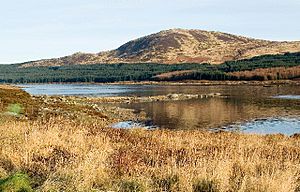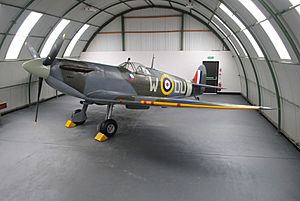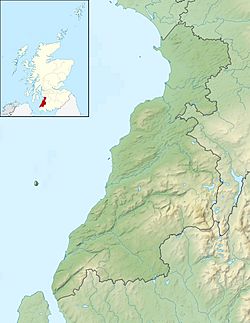Loch Doon facts for kids
Quick facts for kids Loch Doon |
|
|---|---|
 |
|
| Location | Carrick |
| Coordinates | 55°15′00″N 4°22′19″W / 55.250°N 4.372°W |
| Type | freshwater loch |
| Primary outflows | River Doon |
| Basin countries | Scotland |
Loch Doon (which means "Loch Dùin" in Scottish Gaelic) is a beautiful freshwater lake located in Carrick, Scotland. It's a key part of the local landscape. The River Doon starts its journey from the northern end of the loch. Water also flows into Loch Doon from smaller streams like Gala Lane and Eglin Lane, which brings water from Loch Enoch in the Galloway Hills.
Contents
Discovering Loch Doon's Past
Loch Doon has a long and interesting history, from ancient castles to important wartime training sites.
The Story of Loch Doon Castle
In the 1200s, a place called Balloch Castle stood on an island in Loch Doon. It belonged to the powerful Earls of Carrick. During the Wars of Scottish Independence, a Scottish nobleman named Sir Gilbert de Carrick held the castle. He eventually surrendered it to the English, but the Scots quickly won it back.
Later, in the 1400s, the Clan Kennedy often controlled the castle. However, for a short time in 1446, the Clan MacLellan took it over after a siege. In the 1500s, King James V ordered the castle to be destroyed. This was part of his plan to reduce the power of the local noble families.
Loch Doon's Role in World War I
During the First World War, there was a big need to train pilots and aircrew in how to shoot from planes. Loch Doon was chosen as a perfect spot for this training. Its steep hills around the loch were great for setting up target ranges.
Work began in September 1916. An airfield, slipways (for planes to get into the water), piers, jetties, seaplane hangars, and even tramways were built. You can still find the remains of these buildings along the loch's shore today.
How Loch Doon Helps Make Electricity
In the 1930s, a dam was built at Loch Doon. This raised the water level by about 27 feet (8.2 meters). The dam helps store water, especially during rainy seasons, for the Galloway hydro-electric power scheme. This scheme uses water to create electricity.
Loch Doon can hold over 82 million cubic meters of water. When there's a lot of rain, water is sent into the loch from the Water of Deugh through a tunnel system. When electricity is needed, water is released from the loch at Drumjohn. This water then flows into Kendoon power reservoir, which is the first in a series of power stations and reservoirs along the Water of Ken.
During the dam's construction, the ruins of the castle were carefully moved from their original island spot to the shore. This was done to protect them from the rising water levels.
Plane Crashes at Loch Doon
Two aircraft are known to have crashed in or near Loch Doon during the Second World War.
The Hurricane Crash
On March 18, 1944, F/O Roswell Murray MacTavish was on a training flight. He was flying a Hawker Hurricane Mk. IV (LD564) from RAF Heathfield. Sadly, his plane crashed into the forest next to the loch. MacTavish was killed and is buried in Ayr Cemetery. You can still find parts of the aircraft, including its Rolls Royce Merlin engine, at the crash site today.
The Loch Doon Spitfire Mystery

On October 25, 1941, F/O František Hekl, a pilot from No. 312 (Czechoslovak) Squadron RAF, crashed a Spitfire Mk IIA into Loch Doon. He was on a solo training flight from RAF Heathfield. The Spitfire's serial number was P7540, and it had the marking DU-W.
Someone who saw the crash said the Spitfire was flying very low over the water. When Hekl turned the plane, its right wingtip hit the water. The plane broke apart and sank quickly, leaving only an oil slick on the surface. An RAF team tried to find the plane and Hekl's body for several days, but they couldn't.
Years later, in 1977, a group of divers from the Scottish Sub Aqua Club began searching the loch. In 1979, more diving clubs joined the search. They didn't find anything in the first search area.
So, in 1982, they moved their search to a different part of the loch. There, divers quickly found the Spitfire's tail and the back part of its body! In later dives, they found other pieces of the plane scattered over 200 meters. Both wings were badly damaged, and parts made of magnesium (like the landing gear wheels) had rusted away. However, the Merlin Mk XII engine was found in good condition. Hekl's body was never found.
The wreckage was moved to the Dumfries and Galloway Aviation Museum. There, the aircraft was slowly put back together, and new replica wings were added. The restoration was finished in 2017, making it a non-flying display.


